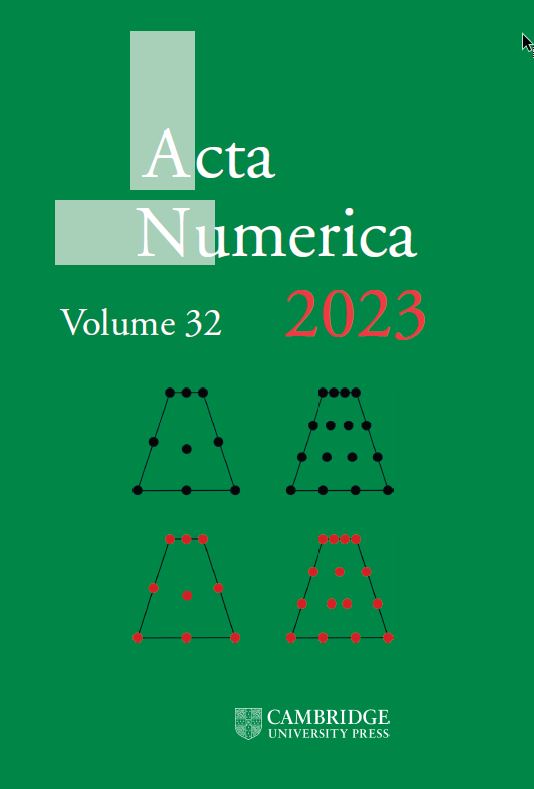稀疏线性系统的直接方法综述
IF 11.3
1区 数学
Q1 MATHEMATICS
引用次数: 160
摘要
威尔金森将稀疏矩阵定义为一个有足够多的零的矩阵,利用它们是值得的这个非正式但实用的定义抓住了求解稀疏矩阵问题的直接方法的本质目标。它们利用矩阵的稀疏性来经济地解决问题:比存储矩阵的所有条目并参与显式计算要快得多,占用的内存也少得多。这些方法构成了计算科学中广泛问题的主干。在已发表的矩阵基准集(Duff and Reid 1979a, Duff, Grimes and Lewis 1989a, Davis and Hu 2011)中,可以看到依赖稀疏求解器的应用的广度。这篇综述文章的目的是传授解决线性系统和最小二乘问题的稀疏直接方法的基本理论和实践的工作知识,并提供可用于解决这些问题的算法、数据结构和软件的概述,以便读者既可以理解这些方法,又知道如何最好地使用它们。本文章由计算机程序翻译,如有差异,请以英文原文为准。
A survey of direct methods for sparse linear systems
Wilkinson defined a sparse matrix as one with enough zeros that it pays to take advantage of them.1 This informal yet practical definition captures the essence of the goal of direct methods for solving sparse matrix problems. They exploit the sparsity of a matrix to solve problems economically: much faster and using far less memory than if all the entries of a matrix were stored and took part in explicit computations. These methods form the backbone of a wide range of problems in computational science. A glimpse of the breadth of applications relying on sparse solvers can be seen in the origins of matrices in published matrix benchmark collections (Duff and Reid 1979a, Duff, Grimes and Lewis 1989a, Davis and Hu 2011). The goal of this survey article is to impart a working knowledge of the underlying theory and practice of sparse direct methods for solving linear systems and least-squares problems, and to provide an overview of the algorithms, data structures, and software available to solve these problems, so that the reader can both understand the methods and know how best to use them.
求助全文
通过发布文献求助,成功后即可免费获取论文全文。
去求助
来源期刊

Acta Numerica
MATHEMATICS-
CiteScore
26.00
自引率
0.70%
发文量
7
期刊介绍:
Acta Numerica stands as the preeminent mathematics journal, ranking highest in both Impact Factor and MCQ metrics. This annual journal features a collection of review articles that showcase survey papers authored by prominent researchers in numerical analysis, scientific computing, and computational mathematics. These papers deliver comprehensive overviews of recent advances, offering state-of-the-art techniques and analyses.
Encompassing the entirety of numerical analysis, the articles are crafted in an accessible style, catering to researchers at all levels and serving as valuable teaching aids for advanced instruction. The broad subject areas covered include computational methods in linear algebra, optimization, ordinary and partial differential equations, approximation theory, stochastic analysis, nonlinear dynamical systems, as well as the application of computational techniques in science and engineering. Acta Numerica also delves into the mathematical theory underpinning numerical methods, making it a versatile and authoritative resource in the field of mathematics.
 求助内容:
求助内容: 应助结果提醒方式:
应助结果提醒方式:


